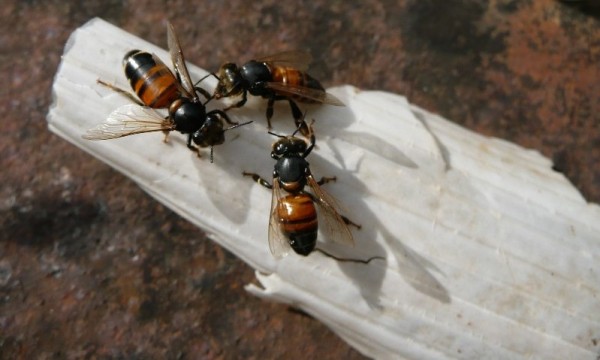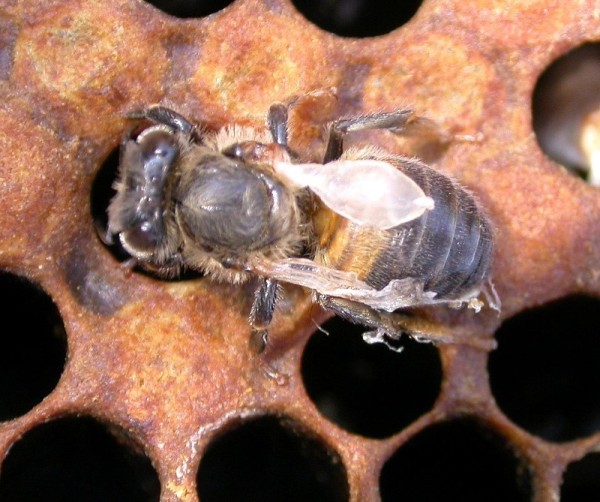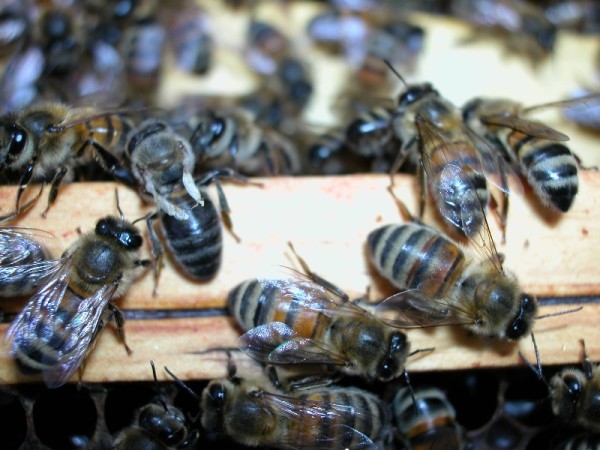Viruses can attack at different developing stages and castes of honey bees, including eggs, larvae, pupae, adult worker bees, adult drones, and queens. Although bee viruses usually persist as inapparent infections and cause no overt signs of disease, they can dramatically affect honey bee health and shorten the lives of infected bees under certain conditions. For example significant infestations of colonies with the Varroa mite (Varroa destructor) and its association with Deformed wing virus (DWV) can seriously harm the health and productivity of honey bees. Many viruses can infect honey bees, but six viruses are commonly recorded around the globe: Deformed wing virus (DWV), Black queen cell virus (BQCV), Sacbrood virus (SBV), Kashmir bee virus (KBV), Acute bee paralysis virus (ABPV), and Chronic bee paralysis virus (CBPV). Note that for the UK, KBV incidence is very low and Israeli Acute Paralysis virus (IAPV) has not been detected despite the completion of very large-scale apiary surveys.
Chronic Bee Paralysis Virus (CBPV)
 Adult bees showing hair loss as the result of a viral infection
Adult bees showing hair loss as the result of a viral infection
The photograph above is a typical example of a CBPV infected bee, all "shiny and black". These bees in infected hives are often found isolated, motionless and/or shaking on the top bars. When the colony is smoked, they do not tend to move down between the frames as the other "normal" bees do. Abdomens may also be distended and the wings dislocated. They can't fly and so can also be seen crawling in front of the hives.
CBPV was identified as a cause of adult bee paralysis after long suspicion that the tracheal mite, Acarapis woodi, was the culprit of the paralysis. CBPV was extracted from naturally paralyzed bees as one of the first viruses isolated from honey bees and has since been detected in adult bees of A. mellifera from almost every continent.
CBPV mainly attacks adult bees and causes two forms of ‘‘paralysis’’ symptoms in bees. The most common one is characterized by an abnormal trembling of the body and wings, crawling on the ground due to the inability to fly, bloated abdomens, and dislocated wings. The other form is identified by the presence of hairless, shiny, and black-appearing bees that are attacked and rejected from returning to the colonies at the entrance of the hives by guard bees. Both forms of symptoms can be seen in bees from the same colony. The variation in the disease symptoms may reflect differences among individual bees in inherited susceptibility to the multiplication of the virus.
Videos showing symptoms of CBPV can be seen below:
Treating CBPV
In crowded conditions, CBPV will spread more rapidly because bees will be in greater contact with each other – increasing the chances that bees will rub up against one another thereby pulling out hairs from their abdomens. This would leave an open wound on the bee where the virus is free to enter and worsen or cause infection in healthy bees. As a result we recommend that in strong colonies showing signs of CBPV, beekeepers ensure there is plenty of room by adding supers or an extra brood box and also that colonies are well fed. CBPV can cause severe problems and if a colony cannot combat the virus through its own means then the recommended method of control is to re-queen a colony with a queen from a less susceptible strain.
Deformed Wing Virus (DWV)
 A young adult bee with Deformed Wing Virus showing typically shrivelled and deformed wings
A young adult bee with Deformed Wing Virus showing typically shrivelled and deformed wings
Symptoms and Diagnosis
While Varroa destructor mite populations are kept under control, DWV persists at low levels in infected colonies without causing any signs of infection because a healthy bees immune system is able to cope with it. However, where mite populations begin to increase and where an immune system is weakened, DWV causes clinical symptoms in developing pupae and can cause pupal death. In addition, newly emerged bees from affected colonies will exhibit deformed or poorly developed wings and can also have bloated, shortened abdomens, as you can see in the picture below.
Methods of Transmission
There are several routes where DWV can be transmitted from one host to another, these include:
- the mating activities between a healthy virgin queen and an infected drone;
- an infected queen laying an infected egg;
- the bees feeding activities, i.e. an infected nurse bee offering food to uninfected brood, bees or the queen;
- Varroa mites feeding activities can greatly increase levels of infection in a host, being a vector to many viruses; and
- at a colony level through swarming and increases made by the beekeeper.
Treatment and Control of DWV
Treatments used to control the Varroa mite should, if correctly used, suppress and control DWV which is associated with the parasite. However, at this moment in time there are no direct methods to control any honey bee virus. There is also evidence to suggest that selection and breeding of virus resistant stocks of bees also help in the control of the virus. However it currently cannot be relied upon in itself as a means of controlling the virus.
 A honey bee displaying signs of Deformed Wing Virus
A honey bee displaying signs of Deformed Wing Virus
